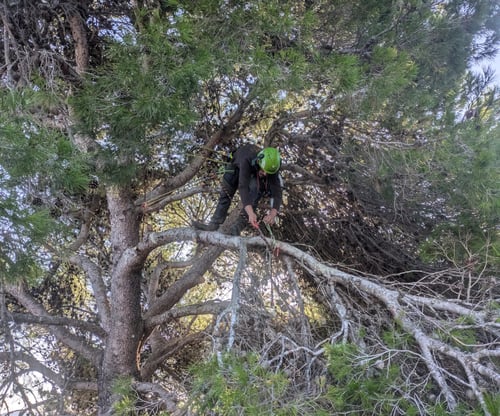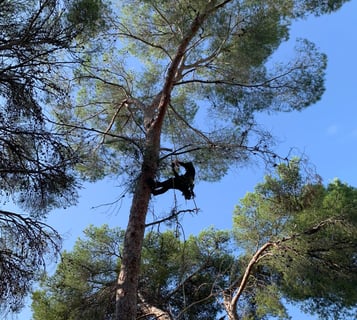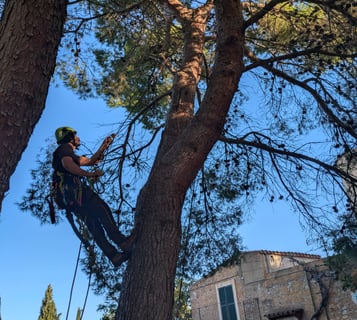Pruning of White Pine (Pinus halepensis) in Mallorca: How to Keep These Trees Healthy and Safe.


The Pinus halepensis, commonly known as the white pine, is a species widely present in Mallorca, especially in mountainous areas, forests, and even private gardens. This type of pine is one of the most representative species of Mediterranean vegetation, highly resistant to drought and the island's extreme climatic conditions. However, proper pruning is essential to keep them healthy, prevent safety risks, and ensure good growth.
In this article, we will explore the importance of pruning Pinus halepensis in Mallorca, the best times to do it, and the correct techniques to maintain a balanced and strong tree.
1. Why is pruning Pinus halepensis important?
The Pinus halepensis is a fast-growing tree that can reach great heights. Despite its resilience, regular pruning is crucial for several reasons:
Safety: Pines can develop dead or damaged branches that pose a danger in urban areas or near buildings, roads, or frequently traveled spaces.
Tree health: Pruning helps remove diseased or pest-affected branches, preventing them from spreading and harming other parts of the tree.
Aesthetics and controlled growth: In Mallorca, where pines are part of the landscape, keeping them well-pruned enhances their appearance and makes them more resistant to the Mediterranean climate.
2. When is the best time to prune white pine?
The best time to prune Pinus halepensis in Mallorca is early spring or autumn, outside the period of intense growth. This allows the tree to recover properly before summer heat waves or winter cold.
It is essential to avoid pruning during the hottest summer months when the tree is in full growth, as this can cause stress or damage. Similarly, in winter, when the pine is dormant, cuts may heal more slowly.
3. Which parts of Pinus halepensis should be pruned?
When pruning a white pine, focus on the following areas:
Dead or damaged branches: These branches not only affect the tree’s aesthetics but can also be a source of disease. Removing them allows the tree’s energy to be directed to healthy parts.
Crossed or poorly oriented branches: If branches grow in a disorganized manner or cross each other, they should be removed to improve the tree’s overall structure.
Lower branches: Removing lower branches that do not contribute much to growth is advisable, especially if they interfere with pathways, spaces, or other trees. This also improves the tree’s appearance.
Branches that pose a risk: In urban areas or near roads, some branches may pose a hazard, especially during strong wind seasons. Removing them helps minimize danger.
4. How to prune properly?
Here are some tips and techniques for effective pruning of Pinus halepensis:
A. Use the right tools
To prune a white pine, it is essential to use well-sharpened and clean tools. A pruning saw for thick branches and pruning shears for smaller branches are the most suitable. Before starting, make sure the tools are disinfected to prevent the spread of diseases.
B. Make clean, angled cuts
When cutting a branch, do so with a clean cut at a slightly inclined angle. This prevents water from accumulating in the wound, reducing the risk of fungal infections or diseases.
C. Avoid excessive pruning
It is important not to remove too many branches at once. The general rule is not to remove more than 25% of the tree's mass in a single pruning session. Excessive pruning can weaken the tree and affect its growth.
5. What are the risks of improper pruning?
Incorrect or insufficient pruning can lead to several problems:
Safety risks: Dead or damaged branches may fall during strong winds, posing a danger in urban or high-traffic areas.
Pests and diseases: If affected branches are not removed, pests or diseases can quickly spread to other parts of the tree.
Deformations: Without proper pruning, the pine may develop an unbalanced shape or grow disorderly, affecting its health and appearance.
Conclusion
Pruning Pinus halepensis is essential for maintaining the health and safety of pines in Mallorca. Well-executed pruning allows the tree to grow healthily, minimizes risks, and contributes to the beauty of the landscape. If you have any doubts about the best way to prune your pines or need assistance, feel free to contact us.




